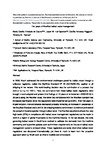Ten years of Brazilian ballast water management
| dc.contributor.author | Trindade de Castro, Maria Cecilia | |
| dc.contributor.author | Hall-Spencer, Jason | |
| dc.contributor.author | Poggian, CF | |
| dc.contributor.author | Fileman, TW | |
| dc.date.accessioned | 2017-02-16T13:54:10Z | |
| dc.date.available | 2017-02-16T13:54:10Z | |
| dc.date.issued | 2017-02-08 | |
| dc.identifier.issn | 1385-1101 | |
| dc.identifier.issn | 1873-1414 | |
| dc.identifier.uri | http://hdl.handle.net/10026.1/8515 | |
| dc.description.abstract |
In 2005, Brazil addressed the environmental challenges posed by ballast water through a unilateral regulation, called the Maritime Standard N° 20 (NORMAM-20), applied to all shipping in her waters. This world-leading decision was the culmination of a process that started during the 1990′s. Here, we summarize how these ballast water regulations were brought in and adopted and present the findings of 10 years of enforcement (2005–2015) in 39 ports along the Brazilian coast. We show that compliance with the Brazilian standard has increased significantly since the regulations were implemented (p < 0.001). After five years of implementation, non-compliance decreased probably reflecting an increase in awareness of the Brazilian Standard and a shift in the shipping industry commitment to minimize and control the spread of invasive species through ballast water. The Brazilian experience shows that very high levels (97%) of compliance with ballast water management regulations can be made to work in a region of global importance to the maritime industry. In the last decade, the rules governing ballast water in Brazil have evolved to address the demands from the maritime community and to provide updates such as imminent requirements for the use of ballast water management systems on board ships. These regulations are rarely cited when ballast water regulations are discussed internationally, yet there is much to learn from the proactive approach taken by Brazil such as what is feasible and enforceable. | |
| dc.format.extent | 36-42 | |
| dc.language | en | |
| dc.language.iso | en | |
| dc.publisher | Elsevier BV | |
| dc.subject | Shipping | |
| dc.subject | Biosecurity | |
| dc.subject | Invasive species | |
| dc.subject | Marine biology | |
| dc.subject | International trade | |
| dc.title | Ten years of Brazilian ballast water management | |
| dc.type | journal-article | |
| dc.type | Journal Article | |
| plymouth.author-url | https://www.webofscience.com/api/gateway?GWVersion=2&SrcApp=PARTNER_APP&SrcAuth=LinksAMR&KeyUT=WOS:000428488100006&DestLinkType=FullRecord&DestApp=ALL_WOS&UsrCustomerID=11bb513d99f797142bcfeffcc58ea008 | |
| plymouth.volume | 133 | |
| plymouth.publication-status | Published | |
| plymouth.journal | Journal of Sea Research | |
| dc.identifier.doi | 10.1016/j.seares.2017.02.003 | |
| plymouth.organisational-group | /Plymouth | |
| plymouth.organisational-group | /Plymouth/Faculty of Science and Engineering | |
| plymouth.organisational-group | /Plymouth/Faculty of Science and Engineering/School of Biological and Marine Sciences | |
| plymouth.organisational-group | /Plymouth/PRIMaRE Publications | |
| plymouth.organisational-group | /Plymouth/REF 2021 Researchers by UoA | |
| plymouth.organisational-group | /Plymouth/REF 2021 Researchers by UoA/UoA07 Earth Systems and Environmental Sciences | |
| plymouth.organisational-group | /Plymouth/Research Groups | |
| plymouth.organisational-group | /Plymouth/Research Groups/Marine Institute | |
| plymouth.organisational-group | /Plymouth/Users by role | |
| plymouth.organisational-group | /Plymouth/Users by role/Academics | |
| dcterms.dateAccepted | 2017-02-05 | |
| dc.rights.embargodate | 2018-2-8 | |
| dc.identifier.eissn | 1873-1414 | |
| dc.rights.embargoperiod | Not known | |
| rioxxterms.versionofrecord | 10.1016/j.seares.2017.02.003 | |
| rioxxterms.licenseref.uri | http://www.rioxx.net/licenses/all-rights-reserved | |
| rioxxterms.licenseref.startdate | 2017-02-08 | |
| rioxxterms.type | Journal Article/Review | |
| plymouth.oa-location | http://dx.doi.org/10.1016/j.seares.2017.02.003 |


